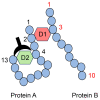Analysis of Crude, Diverse, and Multiple Advanced Glycation End-Product Patterns May Be Important and Beneficial
- PMID: 38276293
- PMCID: PMC10819149
- DOI: 10.3390/metabo14010003
Analysis of Crude, Diverse, and Multiple Advanced Glycation End-Product Patterns May Be Important and Beneficial
Abstract
Lifestyle-related diseases (LSRDs), such as diabetes mellitus, cardiovascular disease, and nonalcoholic steatohepatitis, are a global crisis. Advanced glycation end-products (AGEs) have been extensively researched because they trigger or promote LSRDs. Recently, techniques such as fluorimetry, immunostaining, Western blotting, slot blotting, enzyme-linked immunosorbent assay, gas chromatography-mass spectrometry, matrix-assisted laser desorption-mass spectrometry (MALDI-MS), and electrospray ionization-mass spectrometry (ESI-MS) have helped prove the existence of intra/extracellular AGEs and revealed novel AGE structures and their modifications against peptide sequences. Therefore, we propose modifications to the existing categorization of AGEs, which was based on the original compounds identified by researchers in the 20th century. In this investigation, we introduce the (i) crude, (ii) diverse, and (iii) multiple AGE patterns. The crude AGE pattern is based on the fact that one type of saccharide or its metabolites or derivatives can generate various AGEs. Diverse and multiple AGE patterns were introduced based on the possibility of combining various AGE structures and proteins and were proven through mass analysis technologies such as MALDI-MS and ESI-MS. Kampo medicines are typically used to treat LSRDs. Because various compounds are contained in Kampo medicines and metabolized to exert effects on various organs or tissues, they may be suitable against various AGEs.
Keywords: Kampo medicines; advanced glycation end-products (AGEs); crude AGE pattern; diverse AGE pattern; electrospray ionization-mass spectrometry (ESI-MS); gas chromatography-mass spectrometry (GC-MS); lifestyle-related disease (LSRD); matrix-assisted laser desorption-mass spectrometry (MALDI-MS); multiple AGE pattern.
Conflict of interest statement
The authors declare no conflict of interest.
Figures















Similar articles
-
Slot Blot- and Electrospray Ionization-Mass Spectrometry/Matrix-Assisted Laser Desorption/Ionization-Mass Spectrometry-Based Novel Analysis Methods for the Identification and Quantification of Advanced Glycation End-Products in the Urine.Int J Mol Sci. 2024 Sep 5;25(17):9632. doi: 10.3390/ijms25179632. Int J Mol Sci. 2024. PMID: 39273579 Free PMC article.
-
Characteristics of glycation and glycation sites of lysozyme by matrix-assisted laser desorption/ionization time of flight/time-of-flight mass spectrometry and Liquid chromatography-electrospray ionization tandem mass spectrometry.Eur J Mass Spectrom (Chichester). 2014;20(4):327-36. Eur J Mass Spectrom (Chichester). 2014. PMID: 25420345
-
Mass spectrometry for the study of protein glycation in disease.Mass Spectrom Rev. 2006 Sep-Oct;25(5):713-23. doi: 10.1002/mas.20089. Mass Spectrom Rev. 2006. PMID: 16526005 Review.
-
Is the Novel Slot Blot a Useful Method for Quantification of Intracellular Advanced Glycation End-Products?Metabolites. 2023 Apr 16;13(4):564. doi: 10.3390/metabo13040564. Metabolites. 2023. PMID: 37110222 Free PMC article. Review.
-
Analysis of protein glycation products by matrix-assisted laser desorption ionization time-of-flight mass spectrometry.Curr Med Chem. 2004 Aug;11(16):2185-93. doi: 10.2174/0929867043364649. Curr Med Chem. 2004. PMID: 15279557 Review.
Cited by
-
Advanced Glycation End-Product-Modified Heat Shock Protein 90 May Be Associated with Urinary Stones.Diseases. 2025 Jan 2;13(1):7. doi: 10.3390/diseases13010007. Diseases. 2025. PMID: 39851471 Free PMC article.
-
Slot Blot Analysis of Intracellular Glyceraldehyde-Derived Advanced Glycation End Products Using a Novel Lysis Buffer and Polyvinylidene Difluoride Membrane.Bio Protoc. 2024 Jul 20;14(14):e5038. doi: 10.21769/BioProtoc.5038. eCollection 2024 Jul 20. Bio Protoc. 2024. PMID: 39100597 Free PMC article.
-
Generation and Accumulation of Various Advanced Glycation End-Products in Cardiomyocytes May Induce Cardiovascular Disease.Int J Mol Sci. 2024 Jul 3;25(13):7319. doi: 10.3390/ijms25137319. Int J Mol Sci. 2024. PMID: 39000424 Free PMC article. Review.
-
Slot Blot- and Electrospray Ionization-Mass Spectrometry/Matrix-Assisted Laser Desorption/Ionization-Mass Spectrometry-Based Novel Analysis Methods for the Identification and Quantification of Advanced Glycation End-Products in the Urine.Int J Mol Sci. 2024 Sep 5;25(17):9632. doi: 10.3390/ijms25179632. Int J Mol Sci. 2024. PMID: 39273579 Free PMC article.
References
-
- Manfredelli D., Pariano M., Costantini C., Graziani A., Bozza S., Romani L., Puccetti P., Talesa V.N., Antgonelli C. Severe Acute Respiratory Syndrome Cornonavirus 2 (SARS-CoV-2) Spike Protein S1 Induces Methylglyoxa-Derived Hydroimidazolone/Receptor for Advanced Glycation End Products (MG-H1/RAGE) Activation to Promote Inflammation in Human Bronchial BEAS-2B Cells. Int. J. Mol. Sci. 2023;24:14868. doi: 10.3390/ijms241914868. - DOI - PMC - PubMed
-
- Bednarska K., Fecka I., Scheijen J.L.M., Ahles S., Vangrieken P., Schalkwijik C.G. A Citrus and Pomegranate Complex Reduces Methylglyoxal in Healthy Elderly Subjects: Secondary Analysis of a Double-Blind Randomized Cross-Over Clinical Trial. Int. J. Mol. Sci. 2023;24:13168. doi: 10.3390/ijms241713168. - DOI - PMC - PubMed
Grants and funding
LinkOut - more resources
Full Text Sources
Miscellaneous

